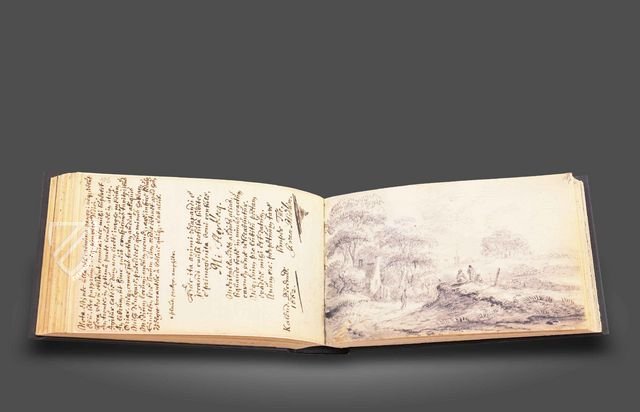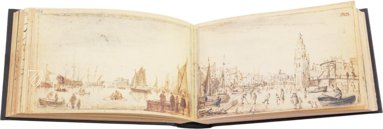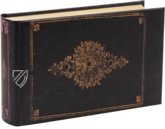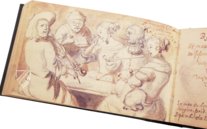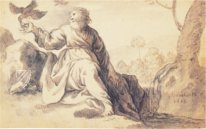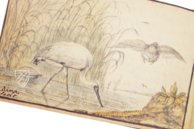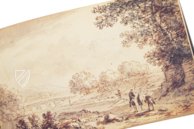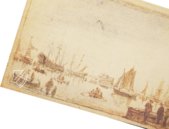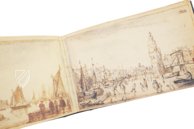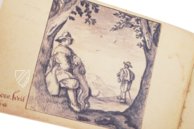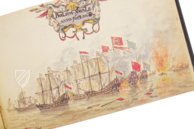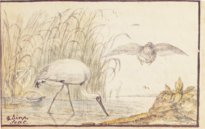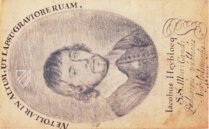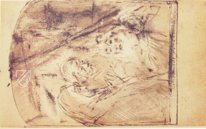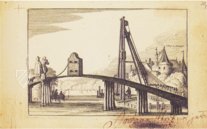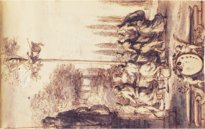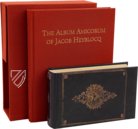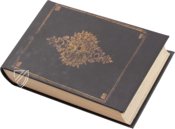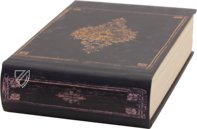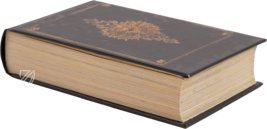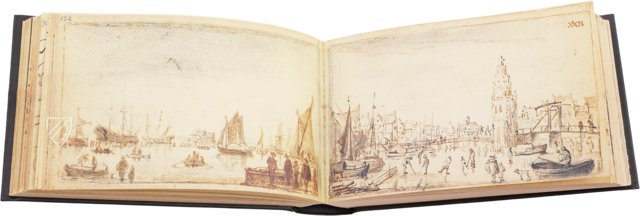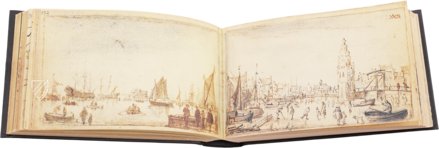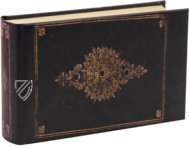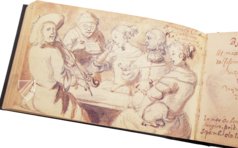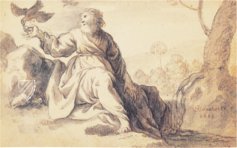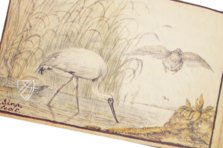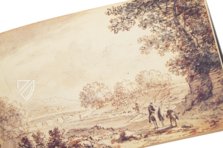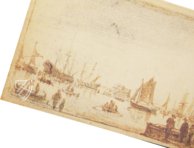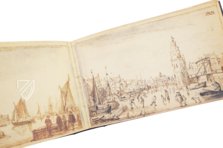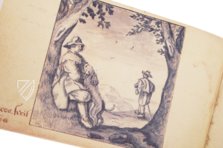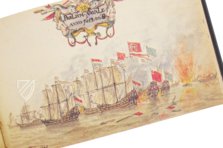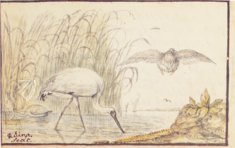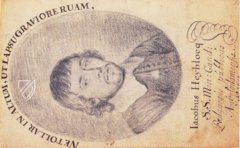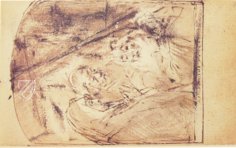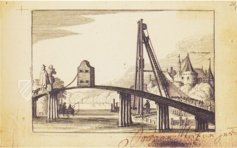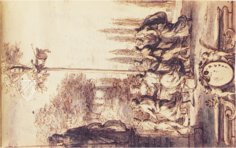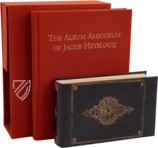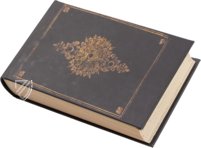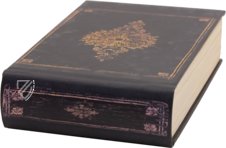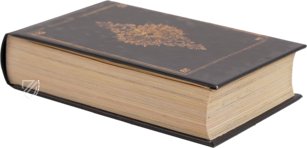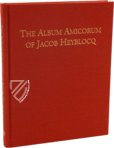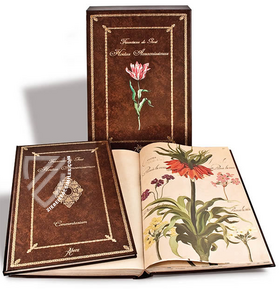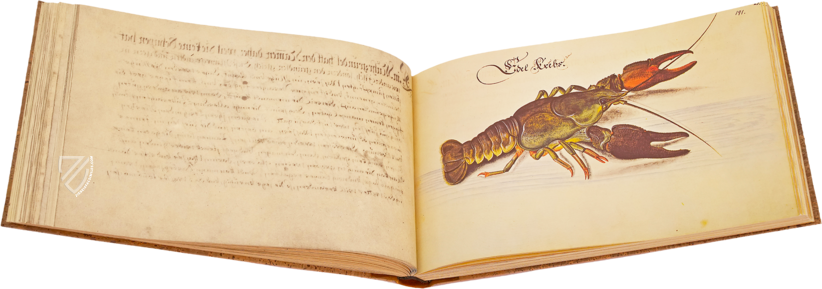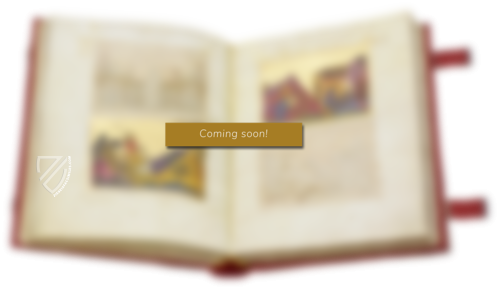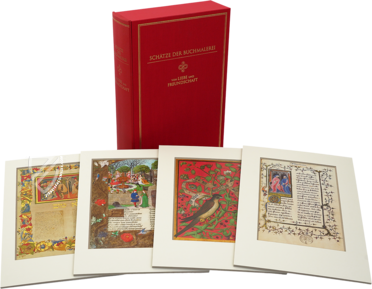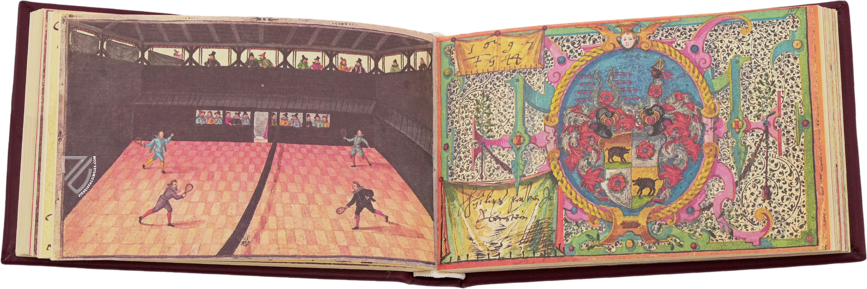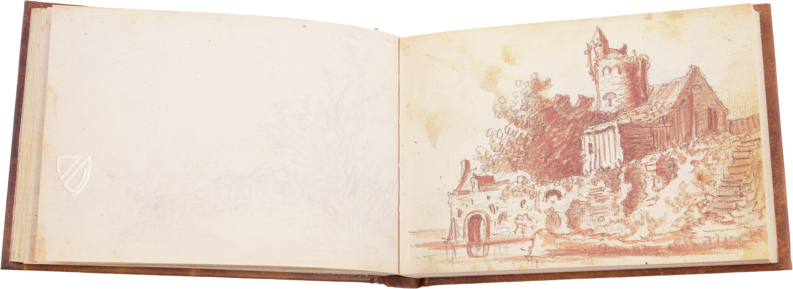Album Amicorum of Jacob Heyblocq
(under 1,000€)
Jacob Heyblocq (1623–1690) lived at a time of economic and cultural prosperity in the Netherlands and was a contemporary of several outstanding artists such as Rembrandt van Rijn, Joost van den Vondel and Aert van der Neer. In 1645, while studying theology in Leiden, he began to compile an exceptional Album Amicorum, which was to far surpass other friendship books of his time in terms of the extent of its contents and its decoration. In it, he collected contributions from illustrious acquaintances and friends far beyond his studies, which were to outlast history. The written entries range from poems composed especially for the vriendenboek to aphorisms and Bible verses in Dutch, Latin, Greek and Hebrew. Among the 41 drawings, 2 engravings and 3 papercuts are numerous genre scenes, wide landscapes, but also biblical topics and a portrait of the owner together with his motto: “Ne tollar in altum, ut lapsu graviore ruam.” - “May I not rise too high because I shall fall all the more heavily.”
Album Amicorum of Jacob Heyblocq
In Jacob Heyblocq's (1623–1690) time, it was considered good manners among students to compile an Album Amicorum during their studies and especially during study trips and stays abroad – a kind of friendship book, in which the young men usually collected short inscriptions, friendship confessions, aphorisms and the like from people they met or admired. The handwritten entries were dated and signed and were thus authentic and personal memories of the students' acquaintances and friends. Sometimes the entries were supplemented by authentic drawings, acquired graphics or family coats of arms and portraits.
A Unique Among 17th Century Alba Amicorum
Jacob Heyblocq had different requirements for his vriendenboek. He openly announces this on the first page: He wanted to collect brilliant contributions from the greatest and most learned thinkers, artists and dignitaries in this little book in order to leave a historical footprint – his Album Amicorum would commemorate those very people, and of course himself, beyond his death. At the same time, however, he cleverly combines his grandiloquent announcement with a common modesty phrase: he describes himself as an “unworthy” (Latin "indigni”) whose only joy in life is reading and looking at the album entries.
Who was Jacob Heyblocq?
When Jacob Heyblocq began his friendship book in 1645, he was studying theology in Leiden. After his studies, he taught at a Latin school in Amsterdam, of which he became principal in 1660. In an era of economic, scientific and artistic prosperity in the Netherlands, this position brought him into contact with the city's cultural elite, including various scholars, professors, poets, painters and other artists, all of whom he naturally asked to contribute to his outstanding Album Amicorum.
Illustrious Expressions of Friendship
In Jacob Heyblocq's friendship book, not only did a number of famous people such as Rembrandt van Rijn, Joost van den Vondel, Jacob Cats, Aert van der Neer and Constantijn Huygens immortalized themselves. It is also particularly extensive - both in terms of the text contributions and its illumination. Many poems were composed especially for the Album Amicorum, mostly in Dutch or Latin, with the owner's name often serving as inspiration. But the remaining inscriptions in the form of aphorisms and Bible verses in Latin, Greek and Hebrew are also often much more detailed than usual.
Images of the Highest Quality
What makes the album particularly valuable are the numerous high-quality drawings, most of which take up entire pages and range from genre scenes and landscape painting to the depiction of biblical scenes, such as Rembrandt's pictorial contribution. It also features a Portrait of Jacob Heyblocq attributed to Pieter Hoff. His accompanying inscription spells out the sitter's motto, which does not fit in at all with the claim formulated at the beginning: “Ne tollar in altum, ut lapsu graviore ruam.” – “May I not rise too high, for I will fall all the lower.” The total of 41 drawings, 2 engravings and 3 paper works make this inconspicuous little book the most beautiful and most extensively illuminated Album Amicorum in Dutch history.
Codicology
- Alternative Titles
- Freundschaftsalbum des Jacob Heyblocq
Jacob Heyblocqs vriendenboek - Type
- Manuscript on paper
- Size / Format
- 310 pages / 9.2 × 15.3 cm
- Origin
- Netherlands
- Date
- 1645–1678
- Epochs
- Style
- Illustrations
- 41 drawings, 2 engravings, 3 papercuts, and 1 title page
- Content
- 196 entries from acquaintances and friends of Jacobus Heyblocq
- Artist / School
- Jacobus Heyblocq
Rembrandt van Rijn
Joost van den Vondel
and many more - Previous Owners
- J. Kneppelhout
U. M. Kneppelhout-Van Braam
Album Amicorum of Jacob Heyblocq
Aert van der Neer – Skating at the Montelbaanstoren
Aert van der Neer (1603/04–1677) was one of the most important landscape painters of the Dutch Baroque period. He contributed several city views to Jacob Heyblocq's friendship book, one of which shows the Oude Schans in Amsterdam. The wide canal is completely frozen over and in the background rises the impressive Montelbaanstoren. Once used as a watchtower for the port facilities, it only served as a bell tower in the 17th century. Meanwhile, numerous ice skaters frolic on the ice and enjoy their winter pastime.
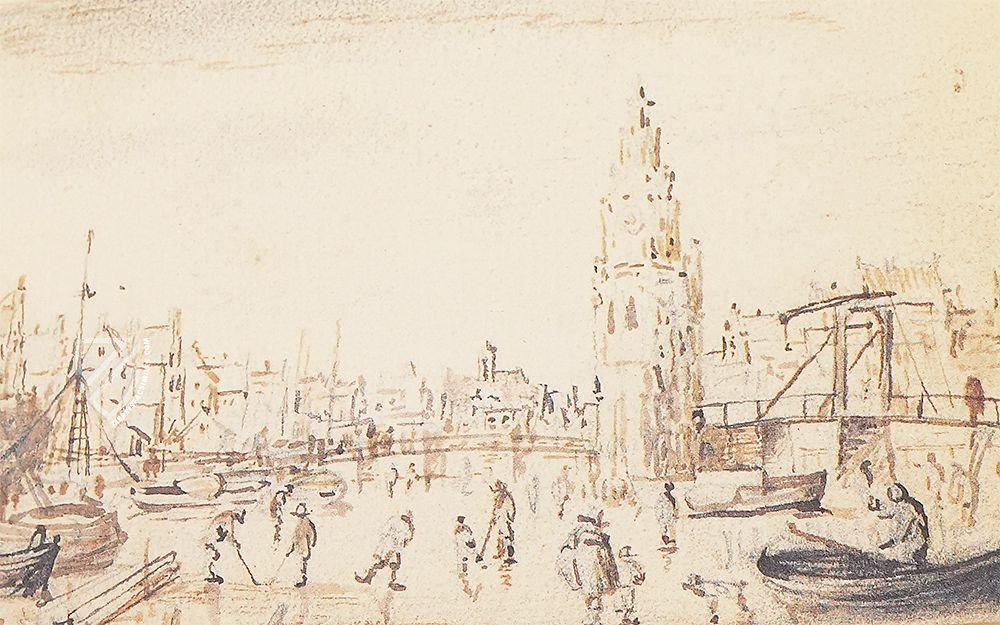
Album Amicorum of Jacob Heyblocq
Rembrandt – Presentation in the Temple
Jesus' Presentation in the Temple is one of Rembrandt van Rijn's favorite biblical themes in his oeuvre. It is based on Luke 2:25-35 and tells of Mary and Joseph bringing Jesus to the temple for circumcision and redemption of the firstborn. There they meet Simeon, whom God gives a particularly long life so that he can personally see the Savior. The Holy Spirit led him to the temple beforehand, where he then gratefully takes the infant Christ in his arms.
In 1661, Rembrandt sets the scene in Jacob Heyblocq's Album Amicorum in portrait format, so that the book has to be turned to view it. The four figures, Mary on the left, Joseph behind her and Simeon on the right with the child in his arms, have been placed in a vaguely suggested interior space using pencil, brush and brown ink. Although the scene takes place in a Jewish temple, a large cross is insinuated above the figures, which appears to emanate from Jesus and seems more like a vision than an actual furniture.
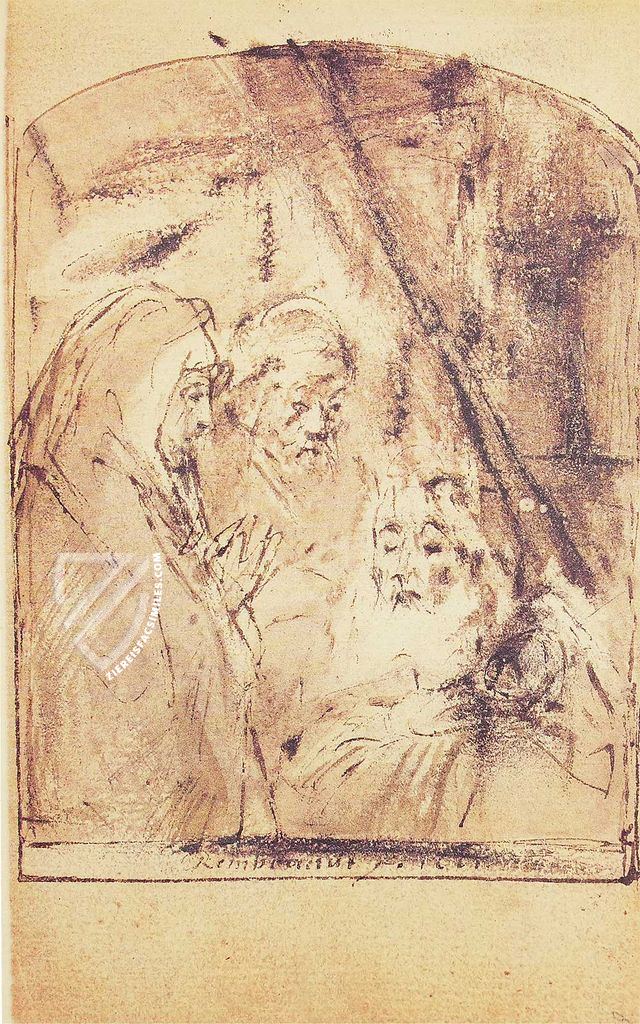
#1 The album amicorum of Jacob Heyblocq
Language: English
(under 1,000€)
- Treatises / Secular Books
- Apocalypses / Beatus
- Astronomy / Astrology
- Bestiaries
- Bibles / Gospels
- Chronicles / History / Law
- Geography / Maps
- Saints' Lives
- Islam / Oriental
- Judaism / Hebrew
- Single Leaf Collections
- Leonardo da Vinci
- Literature / Poetry
- Liturgical Manuscripts
- Medicine / Botany / Alchemy
- Music
- Mythology / Prophecies
- Psalters
- Other Religious Books
- Games / Hunting
- Private Devotion Books
- Other Genres
- Afghanistan
- Armenia
- Austria
- Belgium
- Belize
- Bosnia and Herzegovina
- China
- Colombia
- Costa Rica
- Croatia
- Cyprus
- Czech Republic
- Denmark
- Egypt
- El Salvador
- Ethiopia
- France
- Germany
- Greece
- Guatemala
- Honduras
- Hungary
- India
- Iran
- Iraq
- Israel
- Italy
- Japan
- Jordan
- Kazakhstan
- Kyrgyzstan
- Lebanon
- Liechtenstein
- Luxembourg
- Mexico
- Morocco
- Netherlands
- Palestine
- Panama
- Peru
- Poland
- Portugal
- Romania
- Russia
- Serbia
- Spain
- Sri Lanka
- Sweden
- Switzerland
- Syria
- Tajikistan
- Turkey
- Turkmenistan
- Ukraine
- United Kingdom
- United States
- Uzbekistan
- Vatican City
- A. Oosthoek, van Holkema & Warendorf
- Aboca Museum
- Ajuntament de Valencia
- Akademie Verlag
- Akademische Druck- u. Verlagsanstalt (ADEVA)
- Aldo Ausilio Editore - Bottega d’Erasmo
- Alecto Historical Editions
- Alkuin Verlag
- Almqvist & Wiksell
- Amilcare Pizzi
- Andreas & Andreas Verlagsbuchhandlung
- Archa 90
- Archiv Verlag
- Archivi Edizioni
- Arnold Verlag
- ARS
- Ars Magna
- ArtCodex
- AyN Ediciones
- Azimuth Editions
- Badenia Verlag
- Bärenreiter-Verlag
- Belser Verlag
- Belser Verlag / WK Wertkontor
- Benziger Verlag
- Bernardinum Wydawnictwo
- BiblioGemma
- Biblioteca Apostolica Vaticana (Vaticanstadt, Vaticanstadt)
- Bibliotheca Palatina Faksimile Verlag
- Bibliotheca Rara
- Boydell & Brewer
- Bramante Edizioni
- Bredius Genootschap
- Brepols Publishers
- British Library
- C. Weckesser
- Caixa Catalunya
- Canesi
- CAPSA, Ars Scriptoria
- Caratzas Brothers, Publishers
- Carus Verlag
- Casamassima Libri
- Centrum Cartographie Verlag GmbH
- Chavane Verlag
- Christian Brandstätter Verlag
- Circulo Cientifico
- Club Bibliófilo Versol
- Club du Livre
- CM Editores
- Collegium Graphicum
- Collezione Apocrifa Da Vinci
- Comissão Nacional para as Comemorações dos Descobrimentos Portugueses
- Coron Verlag
- Corvina
- CTHS
- D. S. Brewer
- Damon
- De Agostini/UTET
- De Nederlandsche Boekhandel
- De Schutter
- Deuschle & Stemmle
- Deutscher Verlag für Kunstwissenschaft
- DIAMM
- Droz
- E. Schreiber Graphische Kunstanstalten
- Ediciones Boreal
- Ediciones Grial
- Ediclube
- Edições Inapa
- Edilan
- Editalia
- Edition Deuschle
- Edition Georg Popp
- Edition Leipzig
- Edition Libri Illustri
- Editiones Reales Sitios S. L.
- Éditions de l'Oiseau Lyre
- Editions Medicina Rara
- Editorial Casariego
- Editorial Mintzoa
- Editrice Antenore
- Editrice Velar
- Edizioni Edison
- Egeria, S.L.
- Eikon Editores
- Electa
- Emery Walker Limited
- Enciclopèdia Catalana
- Eos-Verlag
- Ephesus Publishing
- Ernst Battenberg
- Eugrammia Press
- Extraordinary Editions
- Fackelverlag
- Facsimila Art & Edition
- Facsimile Editions Ltd.
- Facsimilia Art & Edition Ebert KG
- Faksimile Verlag
- Feuermann Verlag
- Folger Shakespeare Library
- Franco Cosimo Panini Editore
- Friedrich Wittig Verlag
- Fundación Hullera Vasco-Leonesa
- G. Braziller
- Gabriele Mazzotta Editore
- Gebr. Mann Verlag
- Gesellschaft für graphische Industrie
- Getty Research Institute
- Giovanni Domenico de Rossi
- Giunti Editore
- Graffiti
- Grafica European Center of Fine Arts
- Guido Pressler
- Guillermo Blazquez
- Gustav Kiepenheuer
- H. N. Abrams
- Harrassowitz
- Harvard University Press
- Helikon
- Hendrickson Publishers
- Henning Oppermann
- Herder Verlag
- Hes & De Graaf Publishers
- Hoepli
- Holbein-Verlag
- Houghton Library
- Hugo Schmidt Verlag
- Idion Verlag
- Il Bulino, edizioni d'arte
- ILte
- Imago
- Insel Verlag
- Insel-Verlag Anton Kippenberger
- Instituto de Estudios Altoaragoneses
- Instituto Nacional de Antropología e Historia
- Istituto dell'Enciclopedia Italiana - Treccani
- Istituto Ellenico di Studi Bizantini e Postbizantini
- Istituto Geografico De Agostini
- Istituto Poligrafico e Zecca dello Stato
- Italarte Art Establishments
- Jan Thorbecke Verlag
- Johnson Reprint Corporation
- Josef Stocker
- Josef Stocker-Schmid
- Jugoslavija
- Karl W. Hiersemann
- Kasper Straube
- Kaydeda Ediciones
- Kindler Verlag / Coron Verlag
- Kodansha International Ltd.
- Konrad Kölbl Verlag
- Kurt Wolff Verlag
- La Liberia dello Stato
- La Linea Editrice
- La Meta Editore
- Lambert Schneider
- Landeskreditbank Baden-Württemberg
- Leo S. Olschki
- Les Incunables
- Liber Artis
- Library of Congress
- Libreria Musicale Italiana
- Lichtdruck
- Lito Immagine Editore
- Lumen Artis
- Lund Humphries
- M. Moleiro Editor
- Maison des Sciences de l'homme et de la société de Poitiers
- Manuscriptum
- Martinus Nijhoff
- Maruzen-Yushodo Co. Ltd.
- MASA
- Massada Publishers
- McGraw-Hill
- Metropolitan Museum of Art
- Militos
- Millennium Liber
- Müller & Schindler
- Nahar - Stavit
- Nahar and Steimatzky
- National Library of Wales
- Neri Pozza
- Nova Charta
- Oceanum Verlag
- Odeon
- Orbis Mediaevalis
- Orbis Pictus
- Österreichische Staatsdruckerei
- Oxford University Press
- Pageant Books
- Parzellers Buchverlag
- Patrimonio Ediciones
- Pattloch Verlag
- PIAF
- Pieper Verlag
- Plon-Nourrit et cie
- Poligrafiche Bolis
- Presses Universitaires de Strasbourg
- Prestel Verlag
- Princeton University Press
- Prisma Verlag
- Priuli & Verlucca, editori
- Pro Sport Verlag
- Propyläen Verlag
- Pytheas Books
- Quaternio Verlag Luzern
- Reales Sitios
- Recht-Verlag
- Reichert Verlag
- Reichsdruckerei
- Reprint Verlag
- Riehn & Reusch
- Roberto Vattori Editore
- Rosenkilde and Bagger
- Roxburghe Club
- Salerno Editrice
- Saltellus Press
- Sandoz
- Sarajevo Svjetlost
- Schöck ArtPrint Kft.
- Schulsinger Brothers
- Scolar Press
- Scrinium
- Scripta Maneant
- Scriptorium
- Shazar
- Siloé, arte y bibliofilia
- SISMEL - Edizioni del Galluzzo
- Sociedad Mexicana de Antropología
- Société des Bibliophiles & Iconophiles de Belgique
- Soncin Publishing
- Sorli Ediciones
- Stainer and Bell
- Studer
- Styria Verlag
- Sumptibus Pragopress
- Szegedi Tudomànyegyetem
- Taberna Libraria
- Tarshish Books
- Taschen
- Tempus Libri
- Testimonio Compañía Editorial
- Thames and Hudson
- The Clear Vue Publishing Partnership Limited
- The Facsimile Codex
- The Folio Society
- The Marquess of Normanby
- The Richard III and Yorkist History Trust
- Tip.Le.Co
- TouchArt
- TREC Publishing House
- TRI Publishing Co.
- Trident Editore
- Tuliba Collection
- Typis Regiae Officinae Polygraphicae
- Union Verlag Berlin
- Universidad de Granada
- University of California Press
- University of Chicago Press
- Urs Graf
- Vallecchi
- Van Wijnen
- VCH, Acta Humaniora
- VDI Verlag
- VEB Deutscher Verlag für Musik
- Verlag Anton Pustet / Andreas Verlag
- Verlag Bibliophile Drucke Josef Stocker
- Verlag der Münchner Drucke
- Verlag für Regionalgeschichte
- Verlag Styria
- Vicent Garcia Editores
- W. Turnowski Ltd.
- W. Turnowsky
- Waanders Printers
- Wiener Mechitharisten-Congregation (Wien, Österreich)
- Wissenschaftliche Buchgesellschaft
- Wissenschaftliche Verlagsgesellschaft
- Wydawnictwo Dolnoslaskie
- Xuntanza Editorial
- Zakład Narodowy
- Zollikofer AG

